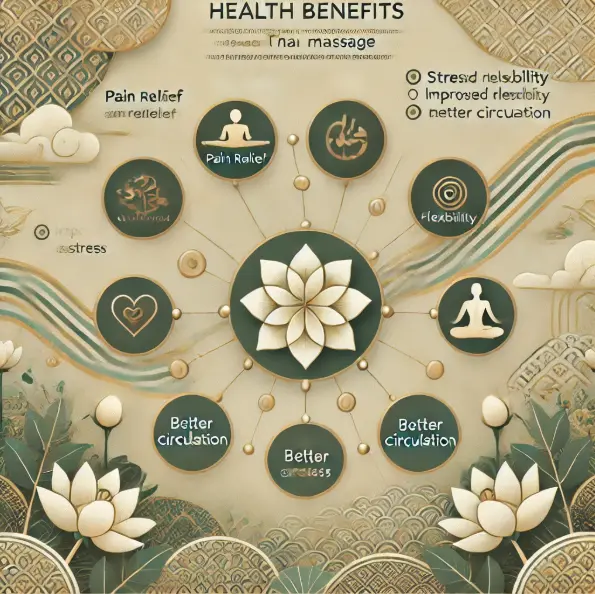
TEXT US

TEXT US
perththaimassage
November 22, 2024
Do not hesitate to contact us. Your enquiries is most welcome.

Thai Massage is more than just a relaxing experience—it’s a holistic therapy that offers a wide range of physical and mental health benefits. This ancient practice blends acupressure, assisted stretching, and rhythmic movement to create a transformative impact on your well-being. Here are 10 incredible benefits of Thai Massage that might surprise you.
Thai Massage targets tension points and realigns the body to relieve chronic pain. Whether it’s back pain, joint discomfort, or repetitive strain injuries, the combination of acupressure and stretching can provide long-lasting relief. Studies suggest that Thai Massage is as effective as physical therapy for alleviating musculoskeletal pain.
The assisted stretches in Thai Massage are often likened to “passive yoga.” These stretches enhance joint mobility and muscle elasticity, making it an excellent choice for athletes or anyone looking to improve their range of motion.
The rhythmic pressure applied along the body’s energy lines stimulates blood flow, promoting oxygen delivery to tissues. Improved circulation reduces swelling, detoxifies the body, and accelerates healing from injuries.
Poor posture often stems from muscle imbalances or tightness. Thai Massage helps correct these issues by releasing tension in the neck, shoulders, and back. With regular sessions, you’ll find it easier to maintain proper alignment.
One of Thai Massages greatest strengths lies in its ability to calm the nervous system. The slow, rhythmic movements induce a state of deep relaxation, reducing cortisol levels and promoting mental clarity.
Beyond stress relief, Thai Massage can help alleviate symptoms of anxiety and mild depression. The focus on energy flow and mindfulness during sessions creates a grounding and meditative experience, enhancing emotional well-being.
The relaxation achieved through Thai Massage extends beyond the session, often leading to better sleep patterns. It’s particularly helpful for those dealing with insomnia or restless nights caused by stress.
By targeting specific energy lines linked to the stomach and intestines, Thai Massage can help improve digestion. Gentle abdominal massage techniques can alleviate bloating and encourage the body’s natural detoxification process.
While relaxation is a key benefit, Thai Massage also boosts energy levels. By unblocking stagnant energy in the body, it rejuvenates both the mind and body, leaving you feeling revitalized and ready to take on the day.
Regular Thai Massage can strengthen the immune system by improving circulation, reducing stress, and promoting overall balance in the body. These effects combine to create a stronger defense against illnesses.
Many of these benefits are supported by research. For example, a study published in the Journal of Bodywork and Movement Therapies found that Thai Massage significantly reduced muscle tension and improved flexibility. Another study highlighted its effectiveness in reducing stress and improving overall quality of life.
Whether you’re an office worker battling back pain or someone looking for a natural way to relieve stress, Perth Thai Massage offers a holistic solution. Its combination of physical relief and energy healing creates benefits that go beyond the surface, making it a unique and effective therapy.
Stay tuned for article 3 in the series
Thai massage involves a combination of assisted stretching, rhythmic compression, and acupressure techniques, while regular massage typically focuses on kneading, stroking, and rubbing of the muscles using various techniques such as effleurage and petrissage. Additionally, Thai massage is rooted in ancient Thai healing traditions and emphasizes balancing the body’s energy flow, whereas regular massage has its origins in Western medical practices and aims to promote relaxation and reduce muscle tension.
Both Thai massage and regular massage can be effective for relieving muscular tension and stiffness, but they approach this goal in different ways. Thai massage uses stretching and acupressure techniques to release tension and improve flexibility, while regular massage employs kneading and stroking motions to relax the muscles and improve circulation. The choice between the two depends on individual preferences and needs.
Thai massage is often favored by athletes and physically active individuals for its emphasis on flexibility and mobility. The assisted stretching techniques used in Thai massage can help to improve range of motion, reduce the risk of injury, and enhance athletic performance. However, regular massage can also be beneficial for athletes, as it helps to alleviate muscle soreness, promote recovery, and prevent overuse injuries.
Both Thai massage and regular massage can promote stress relief and relaxation, but they offer different approaches to achieving these goals. Thai massage combines physical manipulation with mindfulness practices to induce deep relaxation and reduce stress levels. Regular massage, on the other hand, focuses on soothing the muscles and calming the nervous system through gentle, rhythmic strokes. Ultimately, the choice between the two depends on individual preferences and the desired outcome.
While both Thai massage and regular massage are generally safe for most people, there are certain contraindications and health considerations to keep in mind. Thai massage involves stretching and pressure techniques that may not be suitable for individuals with certain medical conditions, such as osteoporosis, herniated discs, or recent injuries. Regular massage, on the other hand, may not be recommended for individuals with skin conditions, open wounds, or certain medical conditions that affect circulation. It’s important to consult with a qualified healthcare professional before undergoing any type of massage therapy, especially if you have underlying health concerns.